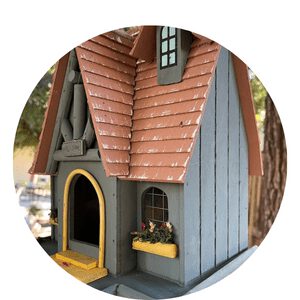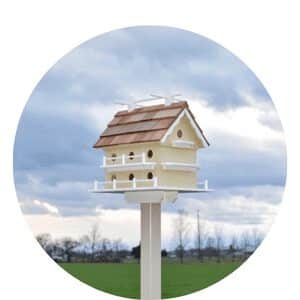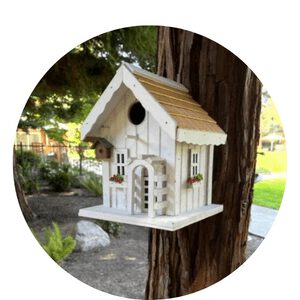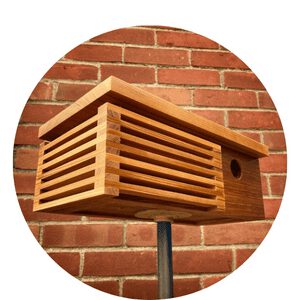What Is The Best Size For A Birdhouse?
When it comes to birdhouses, there is no one size fits all answer.
The type and size of the birdhouse you choose should depend on the type of birds you are hoping to attract and the local climate.
This article will explore different sizes and styles of birdhouses that are best suited for different birds and climates, as well as tips for creating an inviting home for your feathered friends.
Birdshouse Menu
What is a birdhouse?
A birdhouse is a small, man-made structure designed to provide a nesting and roosting place for birds.
Birdhouses are typically made of wood, metal, or plastic and can be found in a variety of sizes and shapes.
They are often used to attract birds to gardens and yards, and can also be used to help protect birds from predators or bad weather.
The size of a birdhouse
When it comes to birdhouses, size does matter!
The size of the house will determine which birds will use it.
Smaller houses are best for wrens, chickadees, titmice and nuthatches.
Medium-sized houses are good for bluebirds, swallows and purple martins. Larger houses are better for woodpeckers, jays and crows.
The placement of the birdhouse is also important. It should be placed in an open area where the birds can see it from a distance.
The house should be mounted on a post or tree at least five feet off the ground. If it is placed too low, predators such as cats and raccoons may be able to get to the birds.
It is also important to keep the birdhouse clean.
Birds will not use a dirty house!
Factors to consider when choosing the size of a birdhouse
When selecting a birdhouse, it is essential to make sure that its dimensions are suitable for the species of birds living in or visiting your yard.
The size of a birdhouse should also be chosen depending on whether you’re aiming to attract nesting birds or just passing visitors.
Furthermore, it should be large enough so multiple families can live in it comfortably while also small enough so predators cannot enter it easily.
Species of birds that will be using the birdhouse
When choosing the right size birdhouse for your backyard, there are many factors to consider.
One factor is the type of bird you want to attract.
Certain species of birds prefer different styles and sizes of birdhouses.
For instance, purple martins often nest in colonies so it is important to install multiple large-sized houses in a group.
The entrance hole should measure about 2 inches across, with an 8 inch by 8 inch floor area inside the house.
On the other hand, bluebirds prefer small houses that are made out of wood or metal and have an entry hole that measures between 1-1/2 and 2-1/2 inches wide.
A birdhouse of the right size, will house each bird in its own wise. It must be low to protect it from rain, And let the birds that enter in remain. It should be small to guard them from foes, But large enough so they can find repose. It need not be fancy or complicated, For a little shelter sure is much appreciated.
Chappy The Gardener
Size of the birds
Size of the birds is an important factor to consider when building a birdhouse.
Different species of birds are different sizes, and therefore require different sized birdhouses to accommodate them.
Learning about the variety of bird sizes can help determine what size birdhouse would be most beneficial for certain types of birds.
Smaller species such as wrens or chickadees need smaller, narrower houses that are two to four inches wide and four to five inches tall.
On the other hand, larger species such as woodpeckers may need larger, wider houses that measure 4-6 inches wide and 8-10 inches tall.
Additionally, if you want your birdhouse to attract multiple species at once then it needs to be large enough for them all fit comfortably inside.
Number of birds that will be using the birdhouse
Birdhouses are often used as a source of shelter and food for birds, making them an important component of any bird-friendly backyard.
The size of the birdhouse can greatly impact the number of birds that will use it.
Therefore, when selecting a birdhouse, it is important to consider the species and number of birds that are likely to be attracted to the structure.
The best size for a birdhouse depends on several factors including the type of bird you wish to attract and the available space in your yard.
Smaller birds such as sparrows typically require smaller houses than larger varieties such as owls or hawks.
Additionally, if there is limited space in your yard, you may need to opt for a smaller house so that multiple species can take advantage of its resources.
Climate and weather conditions in the area
Weather and climate conditions can play a major role in determining the size of birdhouses.
For example, if you are living in an area with cold winter temperatures and harsh storms, it is important to make sure that your birdhouse is large enough to protect the birds from the elements.
Additionally, if you live in a region with heavy rains or high humidity levels, it is best to ensure that the birdhouse has adequate ventilation and drainage holes so that moisture does not accumulate inside.
When selecting a birdhouse size for your area, be mindful of local climate and weather patterns.
Choose materials that can properly insulate during winter months, but also provide ample ventilation for summer months when temperatures are higher.
Taking into account these factors will help create a safe and comfortable habitat for your feathered friends year-round!
Recommended sizes for different bird species
The third part of constructing the perfect birdhouse is determining the size.
It’s important to consider the different sizes that are suitable for various species of birds when building a birdhouse.
When selecting a size, you’ll need to take into account the type and size of the birds you want to attract, as well as their nesting habits.
For instance, if you’re looking to attract sparrows or finches, then your birdhouse should have an entrance hole measuring 1-1/8 inches in diameter.
For bluebirds and chickadees, look for an entrance hole that measures 1-1/4 inches in diameter instead.
Bluebirds
For bluebirds, six inches wide by six inches deep by twelve inches tall is often considered to be the ideal size.
This provides plenty of space for them to nest and to also move around in search of food.
Bluebirds need a place that has enough room for them to build their nests, as well as enough room inside to move around and grab food when necessary.
The box should also be made with rough surfaces on the inside walls so nesting material can easily stick and provide adequate insulation from cold temperatures during the winter months.
The entrance hole should be located at least five feet off the ground, allowing the birds easy access while keeping predators away from their home.
Sparrows
For sparrows, the best size is 4x4x8 inches.
This size allows them enough space to nest and keep their young safe and warm during the winter months. It also gives them enough room to stretch their wings and fly around inside the birdhouse.
A 4x4x8 inch sparrow birdhouse should have a 1 1/2 -inch hole in front for entry, with an interior that has plenty of ventilation holes cut into the sides and roof for airflow.
The floor should be sloped slightly downward so any rainwater can easily run out.
The walls should be insulated with roosting material such as wood chips or shredded paper towels to help keep warmth in during cold weather.
Wrens
Wrens are small birds that typically measure 4x4x8 inches and require smaller nesting boxes than other species of birds.
Therefore, when building a nest box specifically for wrens it is important to keep in mind that they need space to move around in and access their food supply easily.
Most wrens prefer having a hole at the top of their nests so they can have protection from predators while still being able to enter and exit their homes with ease.
When constructing a house for these small birds, it is best to create one that has an opening measuring 1 ½ inches wide by 5 inches tall as this will allow them plenty of room to move about without feeling confined or restricted.
Woodpeckers
Woodpeckers often make their homes in natural tree cavities, however, they can also be attracted to birdhouses that have been constructed for them.
They require a particular size when it comes to creating the perfect home for these birds.
The ideal size for a woodpecker birdhouse is 6x6x12 inches. This allows the woodpecker enough room to enter and exit easily, as well as move around inside of the house comfortably.
In addition, having this specific measurement will also provide adequate protection from any predators who may want to take up residence in the birdhouse instead of the intended woodpeckers.
When building a woodpecker birdhouse it’s important to be precise with measurements and use quality materials in order to create the best environment possible for these feathered friends.
Purple Martins
Purple Martins are a beloved species of bird in North America, and as such, it is important for us to provide them with the best possible habitat.
An essential component of providing a suitable home for Purple Martins is having the right sized house.
The size that many experts recommend for Purple Martin houses is 8x8x12 inches.
This size ensures there are enough interior nesting compartments for the birds and provides them with sufficient room to build their nests.
Additionally, 8x8x12 inch birdhouses have been proven to provide optimal ventilation and insulation for these sensitive birds.
It’s also important to note that nesting boxes should be placed at least 15 feet off the ground on poles or rooftops so they can easily access their homes without any interference from predators.
Tips for building or purchasing a birdhouse
Building a birdhouse is an enjoyable and rewarding project that can be completed by anyone who has access to the right materials.
Whether you decide to purchase a pre-made birdhouse or build one from scratch, there are some important tips to keep in mind.
The following section of this article will provide useful advice for building or purchasing a birdhouse.
The size of a birdhouse should depend on the type of birds found in your area.
For instance, larger cavity nesting birds such as woodpeckers require larger boxes than small, finch-sized birds like chickadees.
When selecting materials for your box, look for untreated wood as treated wood may contain toxins harmful to the birds’ health.
The entrance hole should also be carefully chosen; if it is too large, predators such as cats may have easy access to the nestlings inside.
Use untreated wood to avoid harmful chemicals for birds
One of the most important aspects of building a birdhouse is choosing the right size for the occupants.
However, many people overlook another essential element: using untreated wood to avoid any potential health risks.
Treated woods often contain dangerous chemicals that can have an adverse effect on birds if they come into contact with it.
Using untreated wood will help keep these birds safe from such harmful toxins and ensure their well-being for years to come.
When constructing a birdhouse, it’s important to use untreated wood like cedar or redwood – both of which are natural insect and rot resistant options.
These materials are also lightweight and easy to cut, making them easy to work with when creating your birdhouse design.
Plus, they won’t introduce any harsh chemicals into the environment where they live and can provide sturdy shelter all year long!
Include ventilation and drainage holes
When building a birdhouse, it’s important to consider all the essential components that make it comfortable and safe for the birds.
Ventilation and drainage holes are two key elements to any successful birdhouse design.
These holes allow air to circulate throughout the house, keeping it cool in the summer and preventing moisture buildup in winter months.
Additionally, proper drainage ensures that any built up rainwater or condensation won’t accumulate inside the birdhouse.
The amount of ventilation and drainage needed will depend on what type of birds use your birdhouse as different species have different requirements for air circulation and moisture control.
However, some general guidelines can be followed when choosing the size of ventilation and drainage holes: they should not be too large nor too small; a hole with a diameter between 1/2-1 inch is usually sufficient.
Place birdhouse in a safe location
When it comes to creating a safe and comfortable habitat for birds, one of the most important factors is the location of the birdhouse.
Placing a birdhouse in an area with plenty of trees or on a pole can provide birds with protection from predators while also giving them access to food and water.
The size of a birdhouse depends on the species that will inhabit it.
A smaller house may be suitable for small songbirds, while larger houses are necessary if you want to attract woodpeckers or owls.
Additionally, most species require specific openings in order to enter their nests; some like circular holes, others prefer slots made specifically for their species.
Clean and maintain birdhouse regularly
Good upkeep requires regular inspections and cleaning of the birdhouse so that birds will feel safe nesting there.
The correct size of a birdhouse depends on the type of bird you are trying to attract.
Different species require different sizes—larger ones may need more space while small ones may only need a few inches in diameter or width.
It’s important not to overcrowd the house either, as this can make it difficult for birds to find their way inside and out again safely.
What is a good size bird house?
When it comes to bird houses, one size doesn’t fit all.
The right size bird house depends on the type of bird you want to attract.
Small birds, like chickadees and wrens, need a small bird house with a 1.5-inch diameter opening.
Larger birds, like bluebirds and martins, need a bigger bird house with a 2.5-inch diameter opening.
The height of the bird house is also important. It should be at least 12 inches tall, but no more than 24 inches tall.
If the bird house is too short, the birds will be uncomfortable and might not use it. If the bird house is too tall, it will be difficult for the birds to get in and out.
It’s also important to choose the right material for your bird house.
What is the most common hole size for a birdhouse?
When it comes to birdhouses, size does matter.
The most common hole size for a birdhouse is 1 ½ inches.
This size is perfect for attracting bluebirds, wrens, and other small birds.
If you want to attract larger birds like cardinals and woodpeckers, you will need to make your hole bigger – about 2 inches in diameter.
What dimensions should a bird box be?
When it comes to bird box dimensions, there are a few things to consider.
The size of the entrance hole is probably the most important dimension, as it needs to be large enough for the birds you’re trying to attract to enter.
However, if the hole is too large, predators could also get in, so it’s important to find a balance.
Other dimensions you’ll need to consider are the height and depth of the box.
Does the hole size matter on a birdhouse?
Building a birdhouse is a fun and rewarding project that can be enjoyed by people of all ages.
While there are many different designs and hole sizes to choose from, the size of the hole does matter when it comes to attracting birds.
In order to determine the best size for your birdhouse, it is important to first understand what type of birds you would like to attract.
How high should you put a bird box?
When it comes to nesting birds, you may be wondering how high you should put your bird box.
Placement of a bird house is critical for the success of the birds using it.
wrong location could mean that the birds will not use the house at all or that predators can easily get to the nest and eggs.
follow these tips to help you place your bird box in the right spot.
How do I attract birds to my bird box?
There are many ways to attract birds to your bird box, and each method will work differently for different types of birds.
One way to attract birds is to put up a bird feeder near the bird box. This will give the birds a place to eat while they are getting used to the new box.
Another way to attract birds is to put up a perch near the box. This will allow the birds to get closer to the box and see what is going on inside.
Finally, you can also play music or leave a radio on near the bird box in order to make it more inviting for the birds.
In conclusion, the best size for a birdhouse depends on the species of bird you are trying to attract.
Before purchasing a birdhouse, it is important to consider the structure and size of the birdhouse, as well as where it will be placed in your yard.
Researching different species of birds that may inhabit your area is also key when selecting the right birdhouse.
Ultimately, birds need shelter from predators and weather, so it’s essential to provide them with an adequate home that meets their needs.
Click To Grow
Helps Us Grow – Share If You Like

















